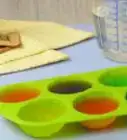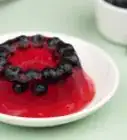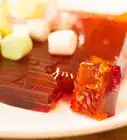This article was co-authored by wikiHow Staff. Our trained team of editors and researchers validate articles for accuracy and comprehensiveness. wikiHow's Content Management Team carefully monitors the work from our editorial staff to ensure that each article is backed by trusted research and meets our high quality standards.
The wikiHow Video Team also followed the article's instructions and verified that they work.
This article has been viewed 633,884 times.
Learn more...
You can add almost any kind of fruit to Jello to make a colorful, delicious dessert. First, wash, cut, and layer your fresh fruit in a bowl or Jello mold. Then, mix regular Jello powder with water, or try using homemade vegan gelatin instead. Pour the gelatin mixture over the fruit and put the dessert in the refrigerator for about 2 hours. Once the Jello sets, remove the dessert from the bowl or mold and enjoy!
Ingredients
- .5 pounds (8.0 oz) of green grapes
- .5 pounds (8.0 oz) of red grapes
- .5 pounds (8.0 oz) of strawberries
- .25 pounds (4.0 oz) of raspberries
- Other fruits of your choice like bananas, pears, or canned pineapple
- 3 ounces (85 g) box of gelatin powder (Jello brand or other brand)
- 1 cup (240 ml) of boiling water
- 1 cup (240 ml) of cold water
- 1.5 tsp of agar-agar flakes
- 1 cup (240 ml) of red grape juice or green apple juice
- 1 cup (240 ml) of water
- .25 cups (59 ml) of white sugar
- A few drops of green food coloring (optional)
Steps
Preparing Store-Bought Jello
-
1Pour a 3 ounces (85 g) box of gelatin powder into a bowl. Use the entire contents of a box of any flavor dessert gelatin. Jello is just one brand name for dessert gelatin and you can buy different brands at your local supermarket.[1]
-
2Add 1 cup (240 ml) of boiling water and stir until the powder dissolves. Boil a cup of water and pour it into the bowl with the gelatin powder. Stir until the powder dissolves entirely. This will take about 2 minutes.[2]
- Use a fork, whisk, or rubber spatula to stir the powder.
Advertisement -
3Add 1 cup (240 ml) of cold water to the mix and stir for a few seconds. The cold water will help get the gelatin to the right temperature and dilute it. If you are using canned fruit in your dessert, you can use the juices from the fruit can, instead of cold water.[3]
- Since the gelatin powder is already dissolved, this won’t take as much stirring.
Choosing and Layering from the Fruit Options
-
1Choose 3 or 4 types of fruit you want to use. Your Jello dessert will look gorgeous if you choose types of fruit that have different colors. For example, you can make a layer of sliced strawberries, a layer of green grapes, a layer of raspberries, and a layer of red grapes. You could slice up a banana for a pop of yellow or put in some canned pineapple for an extra treat.[4]
- If you’re using unflavored Jello, then this isn’t an issue. If you’re using mango-flavored Jello, for example, keep in mind what fruits you like with mango.
- This recipe is very forgiving, but in general you want about 2 pounds (32 oz) of fruit for 1 standard 3 oz package of Jello powder.
-
2Avoid fresh pineapple, kiwi, mango, ginger root, papaya, figs or guava. These fruits react with the Jello in a way that stops the Jello from solidifying. You would end up with a very mushy Jello. However, if you use canned pineapple, it doesn’t have this effect.[5]
- Fun science fact: these fruits contain protease enzymes that stop the proteins in the Jello from solidifying![6]
- If you’re using canned fruit, drain it, but save the liquid. You can use it to make your Jello.
-
3Wash your fruit and slice it into small pieces. Thoroughly rinse your fruit under cold water in a colander. Then slice it into small, bite sized pieces using a knife and a cutting board. If you are using grapes, halve them to look extra pretty. If you’re using strawberries, remove the tops and cut them into halves or quarters. Slice a banana into coins.[7]
- Don’t bother cutting raspberries, blackberries, or blueberries. Just throw them in!
-
4Layer your fruit in a bowl or Jello mold. Start by putting a layer of all of one kind of fruit. If you’re using a .5 pounds (8.0 oz) of strawberries, then put them all in a layer. On top of that, layer your next kind of fruit, and continue until you used all of your fruit. Keeping the fruit in distinct layers will look really pretty once the Jello is done.[8]
- Make sure you don’t use a bowl that curves inward at the opening, or the Jello won’t be able to come out when you flip it upside-down.
- The width of the bowl will determine the thickness of the fruit layers. Use a tall, narrow bowl for thick layers, or a wide, shallow bowl for thin layers, whichever you prefer.
- Don’t worry if the fruit doesn’t fill the whole bowl. The Jello will get into all the cracks between the pieces of fruit.
Making Homemade Vegan Jello
-
1Make homemade vegan Jello if you are vegan or vegetarian. Conventional Jello and other brands of dessert gelatin are made from the ligaments of cows or pigs, so if you are vegan or vegetarian, you should make your own gelatin substitute. You can make it using agar-agar, which is a vegan, jelly-like substance, derived from algae.[9]
- You can buy agar-agar flakes online or at a specialty health food store.
-
2Pour agar-agar, fruit juice, water, and sugar into a pot on the stove. To make red jello, combine 1.5 tsp agar-agar flakes, 1 cup (240 ml) of red grape juice, 1 cup (240 ml) of water and .25 cups (59 ml) of white sugar. To make green jello, combine 1.5 tsp agar-agar flakes, 1 cup (240 ml) of green apple juice, 1 cup (240 ml) of water and .25 cups (59 ml) of white sugar.[10]
- Put your burner on high heat so that the mixture boils more quickly.
-
3Boil the mixture for 2 minutes, stirring regularly. Bring it to a boil, and once it’s fully boiling, start your timer for 2 minutes. After 2 minutes, remove the pot from the heat.[11]
- If you’re making green jello, add in a few drops of green food coloring now.
- If you’re making red jello, you don’t need to put any food coloring.
Pouring and Setting the Jello Dessert
-
1Pour the Jello liquid mixture over the fruit. Cover the fruit completely with Jello mixture. Shake the bowl a tiny bit, so that the Jello filters down to cover the fruit at the bottom of the bowl. [12]
- This works the same for both the conventional and the vegan version.
-
2Place the bowl in the fridge for 1.5 hours. The cold will make the Jello set. If the Jello hasn’t set completely after 1.5 hours, let it refrigerate for another hour.[13]
- If the Jello hasn’t set after 2.5 hours, that means something went wrong. You may want to try again, or make sure your fridge is fully cold.
-
3Turn the bowl upside down onto a plate. Your Jello dessert should fall out onto the plate. If it doesn’t slide out easily, place your bowl into a shallow dish of hot water. The hot water will melt the Jello just a little bit. Once you see a bit of melting, take out the bowl and turn it upside down onto a plate. The Jello will slide right out.[14]
- The layers of colorful fruit will peek through the semi-translucent Jello. If you can’t see them too well from the outside, you will be able to see them once you slice the Jello.
-
4Refrigerate your dessert until you are ready to serve it. You can eat the Jello right now, if you’d like, but if you’re preparing it to serve later, keep it in the refrigerator. To make sure it doesn’t dry out, seal it in a container or cover it in plastic wrap. Jello fruit cakes are great for summer potlucks, holidays, celebrations, or just for a fun treat after dinner.[15]
- Jello lasts about 7-10 days in the refrigerator once you’ve prepared it.
- Don’t put the Jello in the freezer because when you thaw it from frozen it turns into goop.
- When you’re ready to eat your Jello fruit cake, cut it into slices with a sharp knife, just as you would with an ordinary cake.
Community Q&A
-
QuestionMy jello mold is broken. I'm covered in jello. What do I do wikiHow? I need help.
 Community AnswerMake the best of the situation. Be the jello mold you always dreamed of being.
Community AnswerMake the best of the situation. Be the jello mold you always dreamed of being. -
QuestionCan I add fresh strawberries to Jello?
 Community AnswerYes.
Community AnswerYes. -
QuestionCan you use fresh watermelon as your fruit?
 Community AnswerYes.
Community AnswerYes.
Things You'll Need
- Colander
- Knife
- Cutting board
- Cook-pot
- Stirring implement
- Medium-sized bowl or Jello mold
- Refrigerator
References
- ↑ https://www.recipezazz.com/recipe/aunt-bettys-holiday-jello-fruit-salad-mold-2530
- ↑ https://www.chowhound.com/post/jell-instructions-414450
- ↑ https://www.recipezazz.com/recipe/aunt-bettys-holiday-jello-fruit-salad-mold-2530
- ↑ https://momsdish.com/recipe/602/jello-fruit-cake-dessert
- ↑ https://www.scientificamerican.com/article/bring-science-home-fruit-gelatin/
- ↑ https://www.scientificamerican.com/article/bring-science-home-fruit-gelatin/
- ↑ https://momsdish.com/recipe/602/jello-fruit-cake-dessert
- ↑ https://momsdish.com/recipe/602/jello-fruit-cake-dessert
- ↑ https://lovingitvegan.com/vegan-jello/
- ↑ https://lovingitvegan.com/vegan-jello/
- ↑ https://lovingitvegan.com/vegan-jello/
- ↑ https://momsdish.com/recipe/602/jello-fruit-cake-dessert
- ↑ https://momsdish.com/recipe/602/jello-fruit-cake-dessert
- ↑ https://www.recipezazz.com/recipe/aunt-bettys-holiday-jello-fruit-salad-mold-2530
- ↑ https://www.canitgobad.net/can-jello-go-bad/
About This Article
To add fruit to jello, start by adding 1 cup of boiling water to a bowl of gelatin powder. Mix the water and gelatin until the powder dissolves, then add 1 cup of cold water and stir. Next, put the bowl in the fridge for 90 minutes, which will give the jello the consistency of unbeaten egg whites. To add the fruit, stir in 1 cup of chopped canned or fresh fruit to the jello, but be careful not to add extra liquid as this will stop it from setting. Finally, return the jello to the fridge for at least 4 hours to let it set. For tips on how to make designs using fruit, read on!
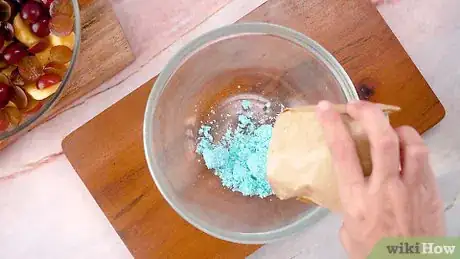
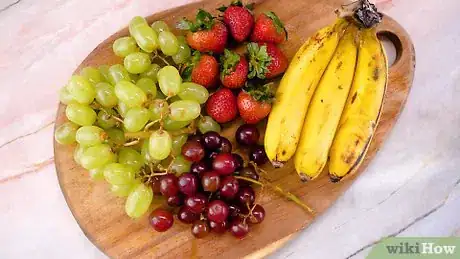
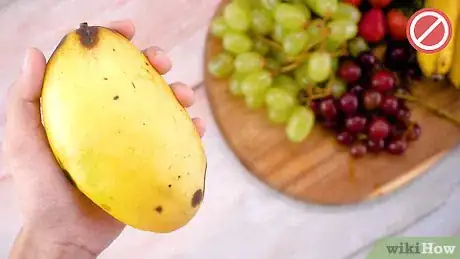
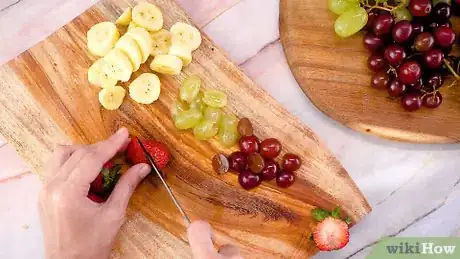
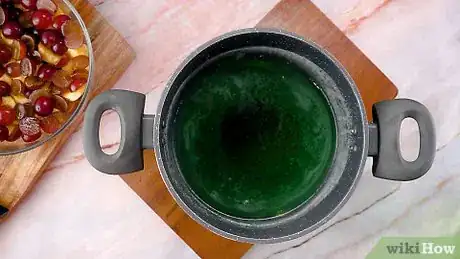
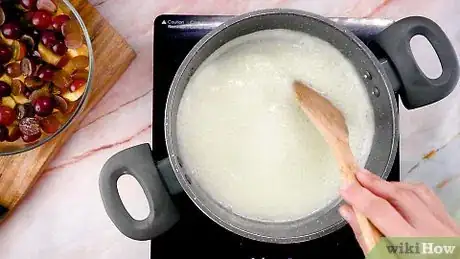
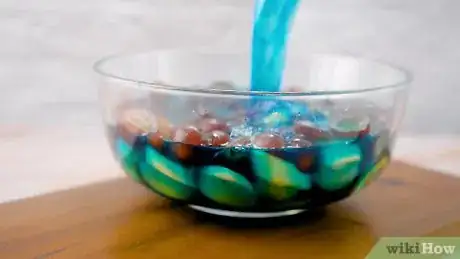

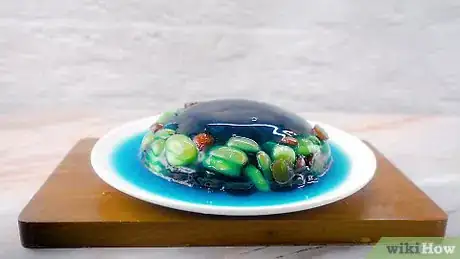
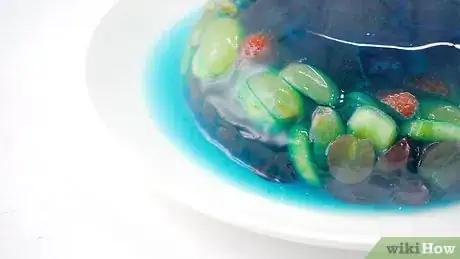
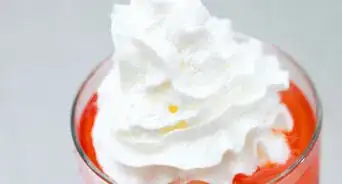
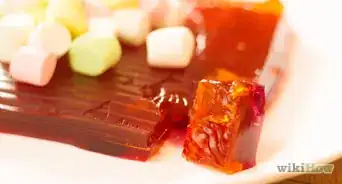


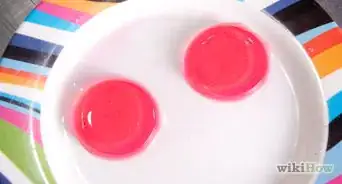
-Step-13.webp)











